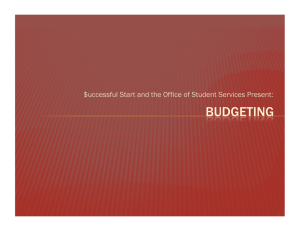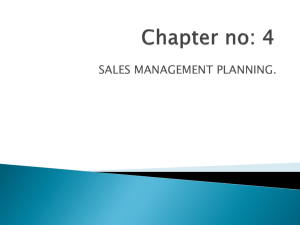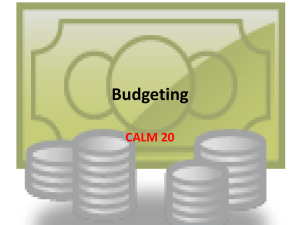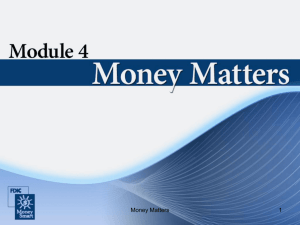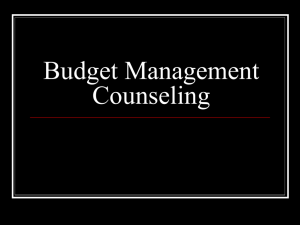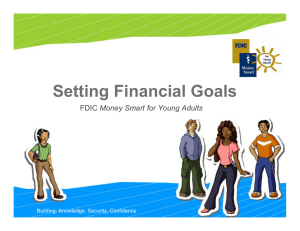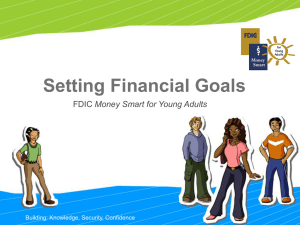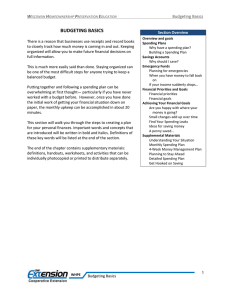BYOB Build Your Own Budget - University of Missouri
advertisement
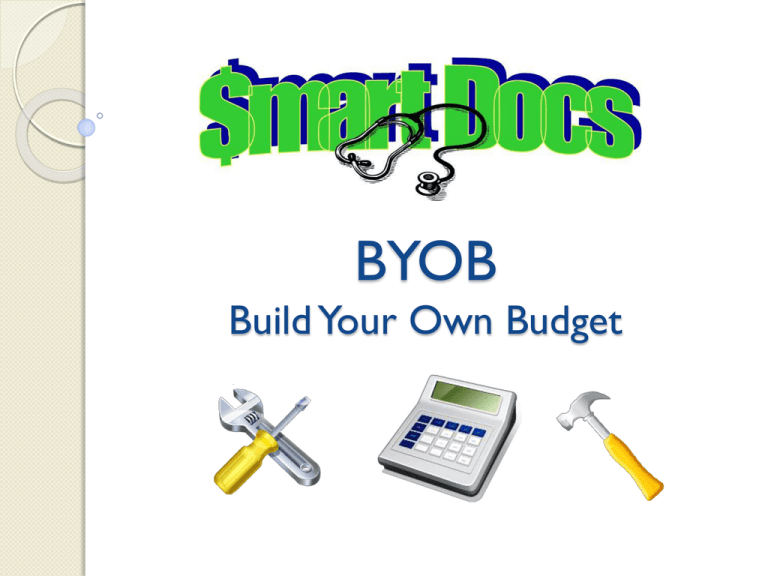
BYOB Build Your Own Budget Build Your Own Budget What is a budget? Spending guidelines ◦ Creating a realistic budget ◦ Budget S.O.S. group activity Making it stick Benefits of starting now Resources Budgeting What is a budget? ◦ Make the most of your financial resources ◦ Determine monthly allowance ◦ Plan how to spend limited funds Why create a spending plan? ◦ Reduce unnecessary expenditures ◦ Unsubsidized loans accrue interest Who can benefit? ◦ Everyone Creating a Realistic Budget Three easy steps…. 1. List the income you expect and when you expect to receive it 2. Write down your expenses – keep a list as they occur 3. Add up the two columns and find a balance Cost of Attendance – 10 months College Expenses under your control ◦ Living expenses - $782 per month ◦ Transportation - $303 per month ◦ Personal stuff - $510 per month College Expenses NOT under your control ◦ Tuition and fees ◦ USMLE exam fees and travel ◦ Books and supplies (allowances by year) M1=$2380, M2=$1020, M3=$930, M4=$560 Spending Guidelines Food 13% Other 10% Savings 10% Transportation 19% Health care 6% Entertainment 5% Clothing 4% Housing 33% Source: U.S. Bureau of Labor and Statistics Budgeting the Cost of Attendance Guideline % Per Guideline Student A Student B Housing – 33% $526 $558 $600 Food – 13% $207 $230 $200 Transport – 19% $303 $300 $210 Clothing – 4% $63 $60 $73 Entertain – 5% $80 $80 $85 Health Care – 6% $96 $207 $207 Savings – 10% $160 $10 $10 “Other” – 10% $160 $150 $120 $1,595 $1,595 $1,505 Monthly Budget COA = $15,950 / 10 months = $1,595 per month *Tuition/Fees, Books/Supplies, USMLE have their own budget. What is $3 a day worth? Daily Cost $3.00 Monthly Cost $90.00 Months in Year 12 Total Yearly Amount $1,080.00 Total borrowed after 4 years $4,320.00 Annual Interest Rate 6.8% Interest after one year on first loan $260.00 Interest after four years on all four loans $604.00 Interest during grace period $145.00 Total owed at repayment Monthly loan payment $58.33 Total payments $7000 Total interest* $2680 *4 yrs school, 6 month grace, 10 year repayment $5,069.00 Financial Aid Adjustments Extra money? Return it! ◦ You have 120 days from disbursement to return any portion of your loan without penalty (it’s in your promissory note) ◦ Email me the details – I can specify which loan to return while you can’t Ask for budget adjustments for car repairs, medical expenses, daycare, computer purchases, etc. Budget Pitfalls Beware of variable expenses like… ◦ ◦ ◦ ◦ ◦ ◦ ◦ Parking Eating out Gifts Fun money Cell phone “Miscellaneous” Dry cleaning/Laundry “Personal finance is 20% head knowledge and 80% behavior.” -Dave Ramsey author of “The Total Money Makeover” Budget SOS (Save On Spending) Discuss budgeting pitfalls and saving tips in the following areas: ◦ ◦ ◦ ◦ ◦ Food Housing Transportation Entertainment Personal Designate a scribe for the group Collection of tips will be posted to web Save on Groceries Become a strategic shopper ◦ ◦ ◦ ◦ Never go shopping hungry! Stick to your list Stock up on items when they are on sale Start a price book so you know when those items typically go on sale ◦ Use coupons when items are already on sale ◦ Know who will double or triple your coupons ◦ Know where to find coupons www.couponmom.com Save on Housing – House vs. Apt House Costs ◦ Electricity and gas ◦ Water, trash, sewer ◦ Yard maintenance +$75 +$65 +$25 Time Costs ◦ Yard maintenance ◦ House cleaning 4 hours 4 hours Total possible monthly savings: $165 Total time savings: 8 hours Save on Transportation Raise insurance deductible to $1,000 Consider dropping comprehensive or collision Shop around for insurance Maintain it Repair it Sell it Car pool Public transportation? Move closer to campus Save on Entertainment Rent a DVD vs. going to a movie Take a few bucks and leave your wallet at home Take poor friends with you! Volunteer for local events Swap and share Do you really need cable? Save on Banking Free checking vs. “free” checking ◦ Balance requirements, checks, etc. ◦ Overdraft fees, bill paying fees, etc. Convenience fees ◦ Check card fees ◦ Using other ATMs Discounts and Services ◦ Using multiple services ◦ Automatic payments ◦ Overdraft protection/Line of Credit Making Your Budget Stick Have a plan and write it down Eliminate temptations Use Cash (or credit….) Prioritize your spending Reward yourself when you meet goals Think long-term (remember 6.8%) Find a system that works for YOU Benefits of Starting Now Save money ◦ Means fewer debt problems ◦ Better prepared for future ◦ Your borrowing from your future income Learn new money tools ◦ Take control of unknown ◦ Be prepared Reduce stress If you aim at nothing……. you’ll hit it every time. Online Resources http://som.missouri.edu/financial/smartdocs/ Office for Financial Success AAMC : FIRST for Medical Education Bankrate.com www.kiplinger.com Mint.com www.daveramsey.com www.suzeorman.com What’s next? Demystifying Credit November 4th at Noon M105
